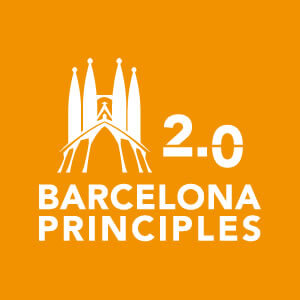The Barcelona Principles have been criticized for not being practical. Watch out for a new how-to framework in the spring.
The original Barcelona Principles, created in 2010, were adopted by more than 200 international measurement conference delegates from 30+ countries representing practitioners, vendors, and global comms trade bodies including AMEC, ICCO, the IPR, and the PRCA.
Deliberately broad, they provided overarching guidance and some common alignment to a fragmented measurement sector which was beset by proprietary indexes and an over-reliance on the flawed AVE metric.
By 2015 it was time to refresh the Barcelona Principles to bring them into the modern era. No longer with just PR in mind, they act as guidance for the integrated communications world of today.
The refresh is an evolution, not a revolution. The Barcelona Principles remain overarching guidance on measurement best practice—a 50,000 foot view, if you will.
No AVE: Now What?
A common criticism of the Barcelona Principles is that having killed off AVEs, they failed to provide a suitable replacement metric. In today’s world where tools, platforms, dashboards, charts and metrics proliferate, people are looking for a simple alternative metric.
This search won’t bare results. There is no magic bullet metric that works in all scenarios. The diverse nature of communications and the differing goals that it supports explains this.
Measuring Beyond Earned Media
The massive changes the PR and media industries have been through have meant existing marketing silos are collapsing.
Communications now integrates many skills and techniques—no longer is it just the domain of earned media, but often includes owned, shared, and paid, too. Communications measurement needs to reflect this and include all areas of the PESO model.
Spin Sucks has covered this need to measure integrated communications before.
Meaningful Measurement
Many of the metrics that communications measurement has relied on for years are now losing their relevance. Volume, impressions, and reach are all difficult to measure accurately and consistently in the new digital media universe.
There are many new digital metrics available which are easy to source and count. Problems exist here too, though. Many can be easily cheated or gamed.
Even if this hasn’t happened, most fail the so what factor. So what if there were X tweets, Y likes and Z pins? The questions being asked in today’s boardrooms are about how this activity has aligned to and supported the organizational objectives.
Just because metrics might be easy to count, doesn’t mean they matter.
We need to move our measurement thinking from counting outputs alone to proving value and relevance to organizational goals.
The Challenge
We have a communications industry working to myriad of objectives, utilizing different techniques via multiple channels with varying budgets, in different markets and locations looking for guidance on how to measure effectively.
A simple one size fits all metric doesn’t work. Our solution has to work in all scenarios, be meaningful and credible, relevant and appropriate while speaking to organizational objectives.
So how best to put these new principles into measurement practice?
The answer is a practical framework that does for measurement what #PRstack has done for tools and workflow.
A number of frameworks currently exist, including the AMEC valid metrics framework, which was launched in 2011 to support the original Barcelona Principles.
Other examples include the more recent social media measurement framework with its accompanying user-guide.
Barcelona Principles 2.0
AMEC will be replacing these with a single new integrated communications measurement framework building on what it has learned during the last five years. The new framework will launch in early 2016.
It will incorporate all of the PESO channels and show how appropriate metrics can be used from activity to output, audience outtake and organizational outcome. There will be a suite of metrics to consider, including definitions and advice on where best to source them.
The framework will be made available online at the AMEC website, fully interactive and feature a step-by-step guide with the ability to save a customized measurement program at the end of the process.
Use of the tool will be free and is, of course, vendor agnostic.
Plan for Success
The framework will bring into focus the importance of planning in the communications process.
The PR industry has often been accused of S.O.S. (just ‘Sending out Stuff’) in the words of U.K. Government communications head Alex Aiken.
To avoid this clear measurable objectives must be established at the outset of a campaign which drive all activity, strategy, and tactics.
This approach has enabled U.K. Government communications to save half of its budget while becoming measurably more effective.
The framework will reinforce the importance of planning to a successful communications strategy by linking desired outcomes to communications activity from the outset.
Spread the Word
The framework will help an industry overwhelmed by data to cut through jargon, confusion, and conflicting advice. Using the framework will empower communications professionals to prove the value of their work in a way that makes sense to their organization regardless of objective, budget, or measurement tool and vendor.
The focus will be on measuring what matters, not counting what’s easy to count.
I urge you to look into the revised Barcelona Principles 2.0 and the soon to be launched accompanying framework and please help us to spread the word.
